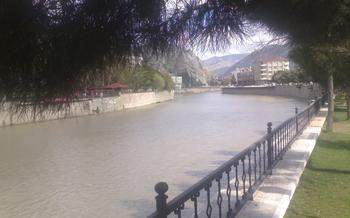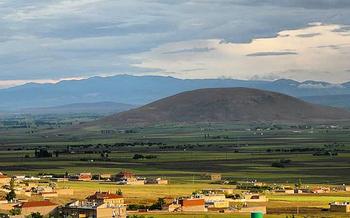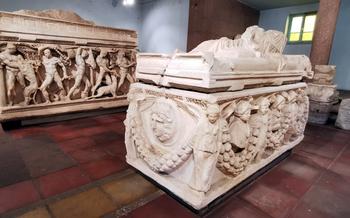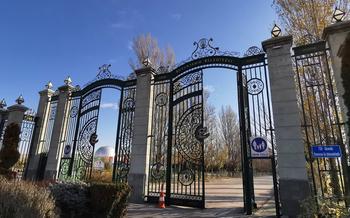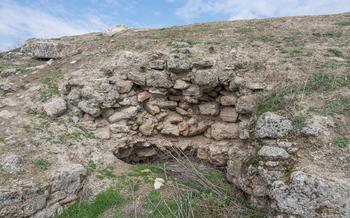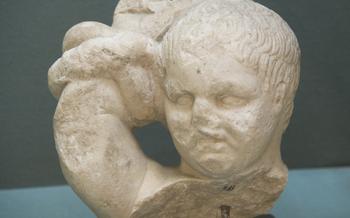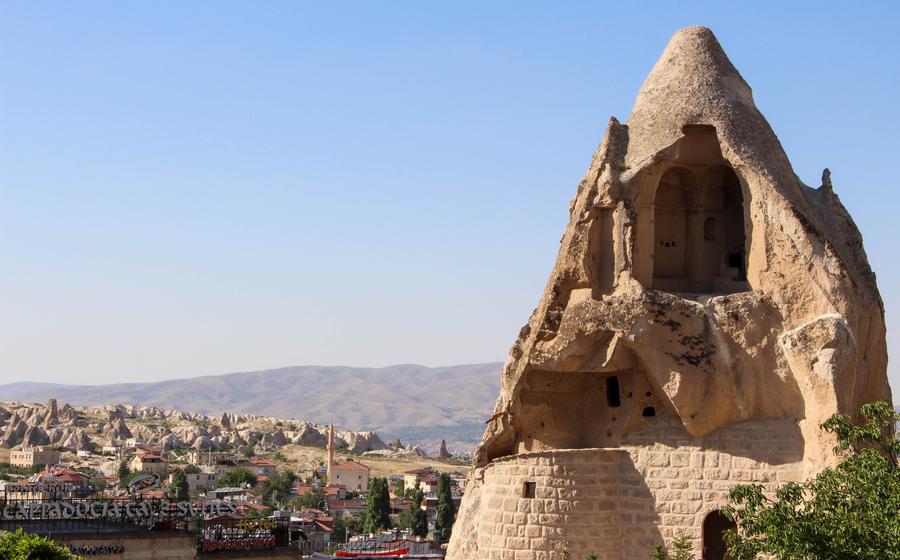
Cappadocia Ethnographic Museum
- The Cappadocia Ethnographic Museum: A Journey into Cultural Heritage
- Location and Accessibility:
- Museum Hours and Ticket Prices
- Exploring the Museum's Exhibits
- History of Cappadocia and Its People
- Traditional Lifestyle and Craftsmanship
- Architecture and Cave Dwellings
- Social Life and Customs
- Cultural Exchange and Trade:
- Tools and Technology:
- Music, Dance, and Folklore
- Education and Literacy
- Children's Activities
- Insider Tip: Enhancing Your Cappadocia Ethnographic Museum Experience
The Cappadocia Ethnographic Museum: A Journey into Cultural Heritage
Nestled in the heart of Cappadocia, the Cappadocia Ethnographic Museum stands as a testament to the region's rich cultural heritage. Step into this fascinating institution, and you'll embark on a journey through time, discovering the traditions, lifestyles, and beliefs that have shaped Cappadocia's unique identity.
The museum's collection is a treasure trove of artifacts, ranging from traditional clothing and textiles to intricate pottery and ceramics. Interactive exhibits bring the past to life, allowing visitors to experience the region's traditional crafts and techniques firsthand. Educational and entertaining displays provide insights into the history of Cappadocia and its people, making the museum a must-visit destination for anyone seeking a deeper understanding of this captivating region.
Location and Accessibility:
The Cappadocia Ethnographic Museum is conveniently situated in the heart of Nevşehir, Turkey. Its exact address is İbrahimpaşa Mahallesi, Eski Saray Caddesi, No: 6, Nevşehir Merkez/Nevşehir. To reach the museum, visitors can take advantage of the city's public transportation system. Several bus lines, including the No. 1, No. 2, and No. 3, stop within walking distance of the museum. For those arriving by car, there is limited street parking available in the surrounding area. The museum is wheelchair accessible, ensuring that all visitors can comfortably explore its exhibits.
Museum Hours and Ticket Prices
The Cappadocia Ethnographic Museum welcomes visitors from 8:00 AM to 6:00 PM daily, except on Mondays when it is closed. Regular ticket prices are 20 Turkish Lira for adults, while students with valid ID can enjoy a discounted rate of 10 Turkish Lira. Children under the age of 8 are admitted free of charge. The museum also offers special events and guided tours on a regular basis, which may require additional fees or reservations. Online booking and reservations are available on the museum's website, allowing visitors to secure their tickets in advance and avoid queues.
Exploring the Museum's Exhibits
The Cappadocia Ethnographic Museum is a treasure trove of cultural artifacts and interactive displays that bring the region's rich history and traditions to life. The museum's layout is designed to take visitors on a chronological journey through Cappadocia's past, starting from the earliest settlements to the present day.
Must-See Exhibits and Displays
Among the must-see exhibits are the displays on traditional clothing and textiles, which showcase the intricate embroidery, weaving, and dyeing techniques that were once commonplace in the region. The pottery and ceramics section features stunning examples of handmade pottery, including decorative plates, vases, and jugs, each with its own unique design and glaze.
Interactive Experiences and Hands-On Activities
The museum also offers interactive experiences and hands-on activities that allow visitors to engage with the exhibits in a more immersive way. Visitors can try their hand at traditional crafts such as pottery, weaving, and embroidery, under the guidance of experienced artisans. There are also cooking demonstrations and tastings, where visitors can learn about local cuisine and sample traditional dishes.
Guided Tours and Audio Guides
For those who prefer a more structured experience, guided tours are available in several languages. These tours provide in-depth insights into the exhibits and the history of Cappadocia. Alternatively, visitors can opt for audio guides, which offer a self-guided tour with commentary and explanations of the exhibits.
History of Cappadocia and Its People
Cappadocia's history is a rich tapestry of ancient civilizations, each leaving its unique imprint on the region. The Hittites, one of the earliest known civilizations, established their empire in Cappadocia around 1600 BC, leaving behind impressive fortifications and rock-cut structures. Later, the region came under Persian, Hellenistic, and Roman rule, each contributing to its cultural and architectural heritage.
The unique rock formations of Cappadocia were formed over millions of years through volcanic eruptions and erosion. These formations, combined with the region's strategic location on trade routes, attracted various nomadic tribes and settlers. Over time, they developed a unique culture and lifestyle, adapting to the challenging terrain and harsh climate.
Cappadocia's cultural influences are diverse, reflecting its position as a crossroads of civilizations. Greek, Persian, Roman, and Byzantine influences can be seen in its art, architecture, and traditions. The region's Christian heritage is particularly significant, with many rock-cut churches and monasteries dating back to the early centuries of Christianity.
Throughout history, Cappadocia has witnessed significant events that shaped its destiny. The Byzantine-Arab wars, the Seljuk conquest, and the Mongol invasions all left their mark on the region. Despite these challenges, Cappadocia's unique culture and traditions have endured, making it a fascinating destination for travelers seeking an insight into the rich history and heritage of Turkey.
Traditional Lifestyle and Craftsmanship
The Cappadocia Ethnographic Museum offers a glimpse into the traditional lifestyle and craftsmanship of the region. Exhibits showcase traditional clothing and textiles, handmade pottery and ceramics, and provide insight into local agriculture and farming practices. Visitors can admire intricate embroideries, colorful carpets, and unique weaving techniques that have been passed down through generations. Displays of handmade pottery and ceramics showcase the skill and artistry of local artisans, with a variety of shapes, glazes, and decorative motifs. Interactive exhibits allow visitors to try their hand at traditional crafts such as pottery making, weaving, and woodworking, providing a deeper understanding of the skills and techniques that have shaped Cappadocian culture and heritage.
Architecture and Cave Dwellings
One of the most intriguing aspects of Cappadocia is its unique architecture, particularly the cave dwellings that have been carved into the soft volcanic rock. The Cappadocia Ethnographic Museum offers a fascinating glimpse into the history and construction of these remarkable dwellings.
The museum displays a variety of tools and techniques used in the construction of cave dwellings, including picks, shovels, and chisels. Visitors can learn about the different types of caves, from simple single-room dwellings to elaborate multi-room complexes with kitchens, storage areas, and even stables.
Of particular interest are the underground cities, which were built as a refuge from invaders and natural disasters. These subterranean labyrinths could accommodate thousands of people and included living quarters, storage rooms, ventilation systems, and even churches. The museum provides detailed information and models of these underground cities, allowing visitors to understand their significance and complexity.
Another highlight of the museum's architecture section is the display of rock-cut churches and monasteries. These sacred spaces were carved directly into the rock and often feature intricate frescoes and iconography. Visitors can learn about the history of Christianity in Cappadocia and the role of these churches in the region's cultural and religious development.
Overall, the Cappadocia Ethnographic Museum provides a comprehensive overview of the region's unique architecture, from its cave dwellings and underground cities to its rock-cut churches and monasteries. Visitors will gain a deeper understanding of the ingenuity and creativity of the people who shaped this extraordinary landscape.
Social Life and Customs
The Cappadocia Ethnographic Museum offers a fascinating glimpse into the social life and customs of the region's inhabitants. Through a series of interactive displays and exhibits, visitors can explore the traditional family life, marriage ceremonies, and culinary traditions of Cappadocia.
Exhibits showcasing traditional clothing and textiles provide insights into the vibrant colors and intricate designs that have characterized the region's fashion for centuries. Visitors can marvel at the intricate embroidery and delicate fabrics that adorned the garments of both men and women.
Displays of local cuisine and culinary traditions highlight the rich flavors and unique dishes that have been passed down from generation to generation. From savory kebabs and gözleme to sweet pastries and desserts, the museum offers a tantalizing glimpse into the culinary delights of Cappadocia.
Interactive experiences showcase social interactions and provide visitors with a chance to immerse themselves in the daily lives of the region's people. Through hands-on activities and multimedia presentations, visitors can learn about traditional customs, such as hospitality, respect for elders, and the importance of community.
Cultural Exchange and Trade:
The Cappadocia Ethnographic Museum offers a window into the region's rich history of cultural exchange and trade. Exhibits on local markets and bazaars showcase the vibrant atmosphere and the diverse goods that were traded. Visitors can learn about the importance of the Silk Road, which passed through Cappadocia, and its role in facilitating the exchange of goods, ideas, and cultures. The museum also explores the influence of foreign cultures and traditions on the region, highlighting the impact of trade on Cappadocia's economy and development. Whether you're a history buff or simply curious about the cultural tapestry of this fascinating region, the Cappadocia Ethnographic Museum provides a wealth of insights into the role of trade in shaping the region's identity.
Tools and Technology:
The Cappadocia Ethnographic Museum offers a fascinating glimpse into the tools and technology used by the region's inhabitants throughout history. Exhibits showcase traditional agricultural implements, such as wooden plows, sickles, and threshing boards, providing insight into the region's agricultural heritage. Visitors can also explore displays of irrigation systems, including ancient qanats (underground water channels) and waterwheels, demonstrating the ingenuity of local farmers in harnessing water resources. Furthermore, the museum features examples of woodworking, metalworking, and other crafts, showcasing the skills and techniques employed by local artisans. These exhibits highlight the evolution of technology and its impact on daily life in Cappadocia, offering a deeper understanding of the region's cultural and economic development.
Music, Dance, and Folklore
The Cappadocia Ethnographic Museum offers a vibrant glimpse into the rich musical, dance, and folklore traditions of the region. Exhibits showcase traditional instruments, such as the bağlama, a long-necked lute, the zurna, a double-reed instrument, and the davul, a large drum. Visitors can learn about the history and cultural significance of these instruments, as well as the role they play in local celebrations and festivals.
Interactive exhibits invite visitors to try their hand at playing traditional instruments or experience the rhythmic beats of a folk dance. Demonstrations and performances by local musicians and dancers provide a captivating insight into the vibrant cultural heritage of Cappadocia. Through these exhibits and experiences, visitors can immerse themselves in the infectious rhythms, melodies, and movements that have shaped the cultural identity of this unique region.
Education and Literacy
The Cappadocia Ethnographic Museum offers a glimpse into the educational systems and practices that have shaped the region's cultural heritage. Exhibits showcase old textbooks, educational materials, and writing implements, providing insight into the methods used to teach reading, writing, and other subjects. Visitors can learn about the role of literacy and education in Cappadocian society, and how it has evolved over time. The museum also highlights the importance of storytelling and oral traditions in passing down knowledge and preserving cultural identity.
Children's Activities
The Cappadocia Ethnographic Museum offers a range of interactive exhibits and activities designed to engage and entertain younger visitors. Children can explore a dedicated play area filled with educational games and puzzles that teach them about the region's history and culture. Storytelling sessions and puppet shows bring to life the tales and legends of Cappadocia, captivating young imaginations. Family-friendly events and workshops are regularly organized, providing opportunities for children to learn new skills, create their own crafts, and interact with museum educators. These activities not only make the museum experience enjoyable for children but also help them develop a deeper appreciation for the cultural heritage of Cappadocia.
Insider Tip: Enhancing Your Cappadocia Ethnographic Museum Experience
To make the most of your visit to the Cappadocia Ethnographic Museum, consider planning your trip during the shoulder seasons (spring and autumn) to avoid the peak tourist crowds. This will allow you to explore the exhibits at a more leisurely pace and enjoy a more intimate experience.
After immersing yourself in the cultural heritage of Cappadocia, take advantage of the opportunity to delve deeper into the region's rich history and natural wonders. Combine your museum visit with a hot air balloon ride over the breathtaking Cappadocia landscape. Marvel at the unique rock formations and fairy chimneys from a bird's-eye view, creating memories that will last a lifetime.
Don't forget to capture the essence of your museum visit through photography. While taking pictures, be mindful of the museum's etiquette and avoid using flash photography, which can damage the delicate artifacts.
To complete your cultural immersion, indulge in the local cuisine after your museum visit. Nevşehir offers a range of delectable restaurants and cafes serving traditional Turkish dishes. Savor the flavors of regional specialties like testi kebab, manti, and gözleme, ensuring a truly immersive Cappadocia experience.



